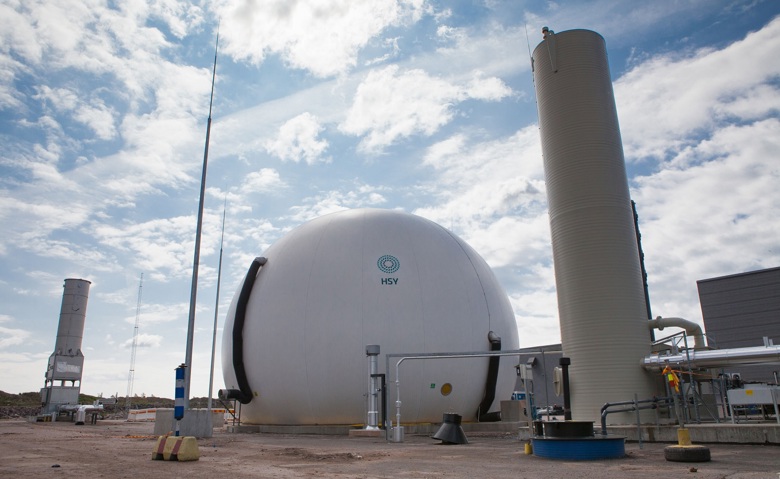Biowaste sorting supports domestic energy and fertiliser self-sufficiency!

Something as mundane as sorting household biowaste supports Finland's energy self-sufficiency. Helsinki Region Environmental Services (HSY) produces biogas from organic waste, which provides electricity and nutritious soil suitable for organic farming. Effective waste recycling also saves nature and raw materials and helps preventing climate change. HSY treats the biowaste of every fifth Finnish household, but it still has a lot of untapped potential. Well over half of the biowaste still ends up in mixed waste.
More than 60 percent of the biowaste of the residents in the Helsinki Metropolitan Area still ends up in mixed waste. However, wet biowaste reduces the energy efficiency of power plants that handle mixed waste,and the nutrients and humic substances in biowaste cannot be utilised. Properly sorted, biowaste is a multi-purpose resource that can also support Finland's security of supply.
The economic sanctions imposed on Russia as a result of the war in Ukraine make it difficult to import many raw materials to Finland, such as natural gas, oil, coal and fertilisers. With careful sorting at home, the energy potential and nutrient utilisation from biowaste could be doubled.
A lot of lost energy potential
HSY produces biogas from the biowaste collected in its area (Helsinki Metropolitan Area and Kirkkonummi, which is home to 22.3 per cent of the Finnish population), which is used to produce heat and electricity. The biowaste treatment plant at the Ämmässuo eco-industrial centre produces about five million cubic meters of biogas annually. It produces about 10,000 megawatt-hours of electricity and almost the same amount of heat.
- HSY could produce up to twice as much domestic energy per year if everyone sorted their biowaste efficiently. With this amount, we could cover the annual energy needs of up to 6,500 apartments, says Tiila Korhonen, operating manager at HSY.
Sorting and utilising waste, especially biowaste, is circular economy at its best. The utilisation of biowaste reduces the need to use and import fossil raw materials and increases energy self-sufficiency, which is particularly important in the current unstable global situation.
Nutritious soil for agriculture and landscaping
Agriculture is predicted to suffer from a shortage of fertilisers and their high prices. The shortage of resources can be partially fixed by soil produced from biowaste, which can also be used for organic farming.
- HSY produces 20,000 tonnes of soil per year from biowaste compost. If everyone sorted their biowaste, this amount would double as well. It means that we could produce up to about 4,000 truck loads of soil a year, says Korhonen.
Agriculture uses a lot of nitrogen fertilisers that are produced using natural gas. Their availability is largely dependent on imports. This is also the reason why the nutrients in cultivation should be as self-sufficient as possible, which supports the security of supply of agriculture and manages the rising costs.
- Compost produced from biowaste contains valuable nutrients such as nitrogen and phosphorus. In addition, the compost soil returns valuable organic humus to the cycle, which improves cultivation features, binds carbon and revives species diversity in the soil, says Christoph Gareis, operational manager.
The biowaste treated at the Ämmässuo eco-industrial centre has been utilised as raw material for soil production, for example in landscaping, and as a soil amendment for agricultural needs. In addition, HSY actively carries out research and development work as well as various pilots to improve the efficiency of biowaste treatment and nutrient utilisation.
How everyone can participate in the utilisation of biowaste
Anyone can start by sorting at home and encouraging their acquaintances to do so too. If you are not sorting your biowaste yet, you can easily start by starting to collect for example fruit peels and used filter bags in a decomposing paper bag. Biowaste containers can be found in all housing companies that have at least five apartments. Many residents of small properties are already sorting or composting their biowaste.
In addition to waste collection, HSY continuously develops and facilitates the sorting of residents' biowaste through various activities, campaigns and cooperation projects:
- HSY's waste guide and sorting instructions for biowaste
- Sorting tips on the Thank you for sorting! -website
- biojate.info – A comprehensive information package on biowaste and its sorting
- Cool4City – sorting pilot for housing companies
- Various new biowaste container experiments, such as the composter that can be emptied into a refuse truck and the ventilated biowaste container
- Annual brushwood collection campaign for small properties as support material for biowaste
- Environmental education in schools and kindergartens.
The benefits of separate collection of biowaste in a nutshell
- Biowaste compost produces nutrient-rich soil for agriculture and landscaping.
- Energy self-sufficiency will increase, the need for importing goods will decrease and the circular economy will become more efficient when electricity and heat are produced from biogas.
- The energy efficiency of waste power plants increases when there is no wet biowaste among the mixed waste.
- The emptying interval for mixed waste bins can be reduced (and in larger housing companies the number of waste containers can be reduced) as biowaste and other waste is sorted more accurately. Mixed waste is the most expensive type of waste for households, so sorting biowaste can also lead to financial savings.
Sorting biowaste is an easy everyday way for every resident to contribute to preventing climate change and improving energy efficiency and self-sufficiency.